General information & terminology
Cashy-POS is used like an ordinary mechanic cash register. While developing this app we took care of all aspects of usability.
Several tests in our own retail shop with employees not being used to work with a computerized cash register showed, that after only three minutes of instruction they were able to use Cashy-POS without any problem!
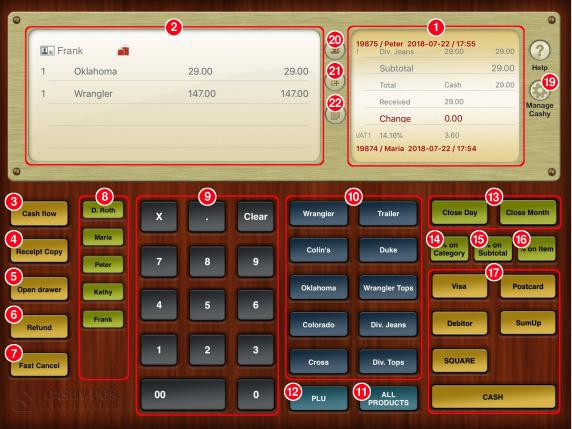
Transaction : A closed sale. A sale is closed, when one of the 7 payment-methods is chosen.
Transaction-ID : Is the automatic increasing number of transactions. It is printed onto every receipt and is not resettable. It’s called also »Receipt number»
PLU : Product-List-Unit, the product number. You can define unlimited products
Product numbers may only contain digits and dots (.) Maximum 15 digits or dots are allowed
Tax : Refers to any tax applied to commercial sales, e.g. VAT, GST, MwSt, etc.
In Cashy-POS you assign a tax rate to the category. All products inside this category will inherit the tax setting from the category.
Under »Manage Cashy > Settings > General» you can define up to three tax rates. In the free Lite-Version the tax rates are fixed and can not be changed!
Close day : Is the action executed at the end of the working day, generating reports of all financial records. A close day is not necessarily related with a calendar day but to the period since the last close day in ‹Z›-mode.
- A close day executed in «X» (X-close) will just generate reports but not reset any counter
- A close day executed in «Z» (Z-close) will reset all counters to zero and can not be repeated, reverted or changed.
You can generate a copy of any close-report under »Manage Cashy > Settings > Etxra > Copy close report»
1 – Subtotal, Log Screen
Since Cashy-POS 1.9, this screen now displays two different views. You can toggle between the two views by taping into the log screen
- SubTotal view
While registering, it displays the permanently updated subtotal of the running transaction. Once the transaction is closed by one of the payment methods, it will display the end parameters of that transaction. Means: payment method, received/returned change, etc
The subtotal view will only display something if at least one item is added to the transaction-screen (top left) - Log-View
In this screen you can see all transactions and events since the last «Close-Day»-event in »Z»-mode.
You can scroll through all transactions and if tapping longer, you can choose to send all transactions to the receipt-printer. After a «close day» in Z-mode the Log-Screen will not contain any data.
2 – Transaction-Screen
This screen shows the transaction in process.
- In the top right corner it shows what you are typing on the numerical keyboard
- In the top-left corner it displays the active user
- In the middle it will display the name of the contact assigned to that transaction (if ever)
- Swiping horizontally over a registered product will pop up a green «Invert» button and a red «Delete» button:
– «Delete«: Will remove the chosen line (item) when tapped (see «Fast Cancel»)
– «Invert«: Will invert the transaction (change the + into – ) which is useful when a client want to return a product in exchange of another one. This way both products will be registered in a single transaction and will be printed on the same receipt.
Example: »2 x Jeans 20.00» will become »-2 x Jeans -20.00» - Taping onto an already registered item, its count will increase by one
3 – Cashflow
Only authorized users can access this function. You can define user rights in the users section.
In the pop-up window you can manage all cash related actions like :
- Define your »Small Cash» (the coins and banknotes you use as change
- Enter the amount of cash you pick-up from the drawer to bring to your bank (»Bank-Deposit»)
- Enter the amount of cash you pick-up from the drawer to pay good or services used in your shop (»Other Expenses»)
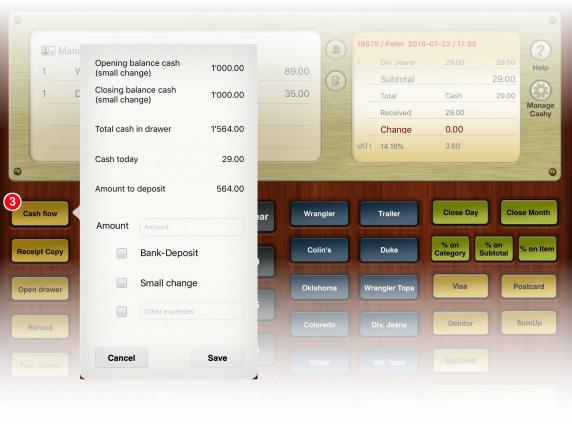
The pop-up window will also inform you about :
- »Opening balance cash (small change)» : Shows the small change available in the drawer after a »Close day» in Z-mode
- »Closing balance cash (small change)» : Shows the small change currrently available in the cash drawer
- »Total cash in drawer» : Shows the sum of «Small cash» plus the cash sales accumulated over time
- »Cash today»: the cash from sales accumulated in the drawer since the last Close day action
- »Amount to deposit» : This is the accumulated amount of cash sales available to deposit at the bank
Example how this function calculates:
- You start your business and add 1000 to the »Small cash»
>>> »Opening balance cash (small change)» will display 0
>>> »Closing balance cash (small change)» will display 1000
>>> »Total cash in drawer» will now show all a value of 1000
>>> »Cash today» will be 0
>>> »Amount to deposit» will be 0 - Now you realize that you forgot to buy pencils and buy some in the shop near you for 10. You tick the field »Other Expenses» and write »Pencils» into it. Add 10 as amount on top
>>> »Opening balance cash (small change)» will still show 0
>>> »Closing balance cash (small change)» will show 990
>>> »Total cash in drawer» will show 990
>>> »Cash today» will show -10
>>> »Amount to deposit» will still show 0 - A customers visits your shop and buys something for 5 paid in cash
>>> »Opening balance cash (small change)» will still show 0
>>> »Closing balance cash (small change)» will show 995
>>> »Total cash in drawer» will show 995
>>> »Cash today» will show -5
>>> »Amount to deposit» will still show 0 (because your small change was reduced when buying the pencils and first the small change will be filled up to 1000)
- Second customer enters and buys for 15 paid in cash
>>> »Opening balance cash (small change)» will still show 0
>>> »Closing balance cash (small change)» will show 1000
>>> »Total cash in drawer» will show 1010
>>> »Cash today» will show 10
>>> »Amount to deposit» will show 10 - You close your shop and go the bank and deposit 10 (tick »Bank deposit» and enter the amount)
>>> »Opening balance cash (small change)» will still show 0
>>> »Closing balance cash (small change)» will show 1000
>>> »Total cash in drawer» will show 1000
>>> »Cash today» will show 10
>>> »Amount to deposit» will show 0 - Now you execute a close-day in ‹Z›-mode
>>> »Opening balance cash (small change)» will show 1000
>>> »Closing balance cash (small change)» will show 1000
>>> »Total cash in drawer» will show 1000
>>> »Cash today» will show 0
>>> »Amount to deposit» will show 0
This function only display cash related information. You must use the dedicated »CASH»-button as payment method that Cashy-POS knows that it is a cash transaction!
Payments by credit cards, etc. will not be reflected here!
4 – Receipt Copy
A copied receipt will always start with the tilte»Receipt copy» in the header
- A short tap onto this button prints a copy of the last transaction
- Tap and hold lets you enter the transaction-ID (receipt number) to be printed aoain
- The receipt copy will even be printed if in settings printing is turned off but the printers IP-address is configured
5 – Open Drawer
This button serves to open the drawer connected to the receipt-printer, without closing a transaction. When a cash transaction is closed, the drawer opens automatically if the »CASH» button is pressed.
Using this function to open the drawer, a small receipt stating »Drawer opened» will be printed and it will be displayed in the log and journal..
You can disable this button in the settings (Extra > »Show button ‹Open Drawer› on main screen»)
6 – Refund / Fast Cancel
6 – Refund
Use this button if you need to cancel any item of a closed transaction,
To do so, you must enter the password from the supervisor or from a user having the right cancelling. You can define these rights in «Manage Cashy > Users»
How-To:
- Tap «Cancel», enter your password and just repeat registering the product you want to cancel and close it using one of the payment buttons
- On top of the transaction screen the words «Cancel mode» are displayed in red until you close this cancel transaction
- If you entered cancel-mode by error, just tap the red coloured «Cancel mode» above of the transaction screen to return to normal registering mode of Cashy-POS
- If you wish cancelling a full transaction, then tap and hold the »Refund»-button. You will be asked for the transaction-ID (receipt number) of the transaction to delete. This will revert the whole transaction!
7 – Fast Cancel
This button cancels the last item from the current (not yet closed) transaction (see «Transaction screen» for other cancel method)
8 – Users / Sellers
In Cashy-POS you can define up to 8 users or sellers in the user-settings.
The name given in the settings are shown on these buttons. Tapping one of the user-buttons immediately changes the user (shown on top of the transaction-screen) and all transactions are associated to this user until a new user has been chosen.
No password is needed to toggle between users.
A long tap onto one of the users buttons will print a short report containing the amounts of the different payment methods cashed from this seller/user since last close-day in ‹Z›-mode
9 – Numerical keyboard
Use the numerical keyboard to enter amounts, product numbers (PLU), etc
10 – Categories
Categories are used for organizing products into logical structures, based on VAT rates.
Cashy-POS allows you defining as many categories as you wish, but only 10 of them can be displayed on main screen.
Defining a category («Manage Cashy > Category») allows you to tag it as «visible on main screen».
Tap and hold one of the visible category buttons on main screen to get a list of products associated to that category. You can filter the list by product number and product name.
11 – All Products
Pops up a list of all products you created . You have the possibility to search for PLU-numbers or part of the product-name or barcodes.
12 – PLU
Product-List-Unit : Is used to enter directly the product-number.
First type the product number (PLU) using the numeric keyboard and then tap the «PLU»-button to register that product.
13 – Close Day / Month
In Cashy-POS a day is defined as the period between two «Close Day» events in ‹Z›-mode. To execute a close, you must enter the password of the supervisor or of a user having the right of closing the day or month. You can define these rights in «Manage Cashy > Users».
Executing a close-day or month you can choose to:
- Send the close report by mail
- Upload the close report to your FTP-server
- Both options above can be combined with printing the report on the receipt printer or an AirPrint enabled printer
- Print the reports onto the receipt-printer or an AirPrint enabled printer
- Additionally you can add a list of sold products (summarized) to the reports (default: ON)
Emailing or uploading close-reports is very recommended. The following files are attached to the message or uploaded:
- Compressed and password protected copy of the database containing all your data and settings (for backup purposes)
- PDF-file showing the sales and other statistics of the closed period
- CSV-file (Comma-Separated-Value) containing the close-reports data
- PDF-file containing all transactions of the closed period in detailed and chronological order
See section «General» for more information
14 – Discounts
14 – % on categrory
It allows you to apply a discount on sales from one category.
Usage : Type the percentage of the discount on the numerical keyboard, then type «% on category» and choose the category where the discount should be applied.
15 – % on SubTotal
Same as above, but applies on the subtotal of the whole transaction.
Usage : Type the percentage of the discount on the numerical keyboard, then type «% on subtotal».
The two discounts on category and on subtotal can not be combined!
16 – % on item
It allows you to apply a discount on sales to a single item.
Usage : Type the percentage of the discount on the numerical keyboard, then type «% on item» and choose the item where the discount should be applied.
Notice: It is not possible to cumulate multiple discounts, (category and item, item and subtotal, etc)
17 – Payment Methods
In «Manage Cashy > Settings» you can define up to 6 different cashless payment options, e.g. Credit Card, Cheque, etc.
See «Help > Settings» for additional information
19 – Manage Cashy
This button leads you to the pages where you can configure users, products, categories, time tracking and general settings of you Cashy-POS installation.
20 – Assign transaction to customer-name
Links a transaction to a person or a company.
You can import contacts from the iPad address book or manually create your own contacts.
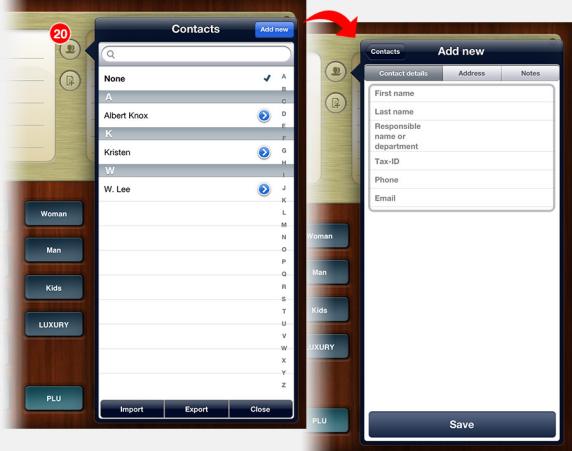
It is possible adding supplemental information using the notes field.
Tap the small blue arrow for accessing the transaction archive of this customer. It will show you the total of all sales or only the total of the current year. You can also access past transactions associated to that customer.
21 – Open new transaction but keep actual one
Allows you to manage multiple open transactions in the meantime.
This button will have no functionality if the transaction screen does not contain at least one product.
Backgrounding a started transaction will ask you for a name of the transaction to be backgrounded. The name-field already contains a unique number which can be replace by user defined text.
If already a contact has been linked to a transaction, it will not ask again for the name but will have the contact name assigned.
When backgrounded transactions exists, an additional button becomes visible. This button (Show open transactions) shows a list of all open transactions, which then can be reactivated (foregrounded) or be deleted.
Important: Before a close-day can be executed, it is mandatory to close all open transactions.
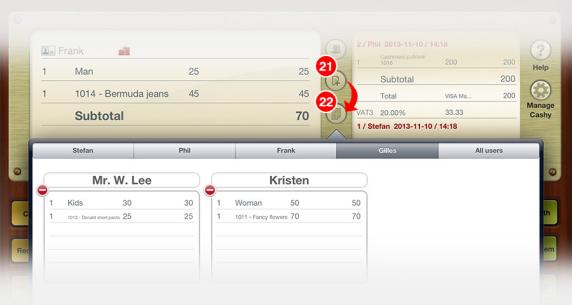
22 – Button «Show open transactions»
This button becomes visible only if open (backgrounded) transactions are existing!
23 – Bestseller Buttons
Slide horizontally the numeric keyboard on main screen to access «Bestseller buttons».
You can place 25 buttons onto each view. Sliding vertically inside the «Bestseller buttons» view, will allow adding another 25 products. May 50 products can be assigned to bestseller buttons
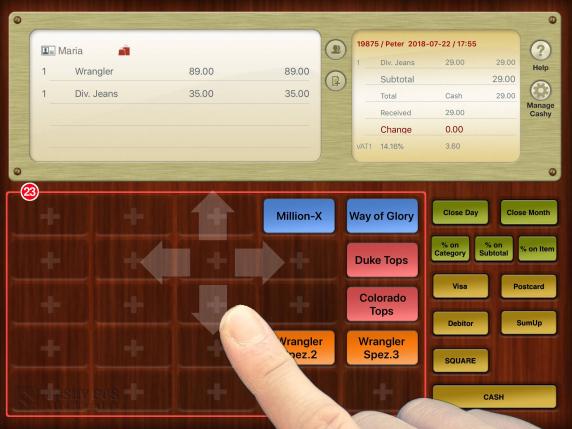
If no products are assigned to buttons, the screen will show «+»-signs as place holders. If the screen is just blank, tap and hold onto it until the «+»-signs are appearing.
Taping onto a «+»-sign will pop-up a list with all products from where you can choose the product to be assigned to that button as well as one of 10 colours and some font options
Each product can be assigned to only one button.
A longer tap onto a button allows removing or editing this product button.
Tap somewhere on the background to quit the button configuration mode which will hide the place holder signs.
Each tap onto a bestseller button will increase the registered number of items by one. This avoids sliding back to the numerical keyboard for registering multiple times the same product.


